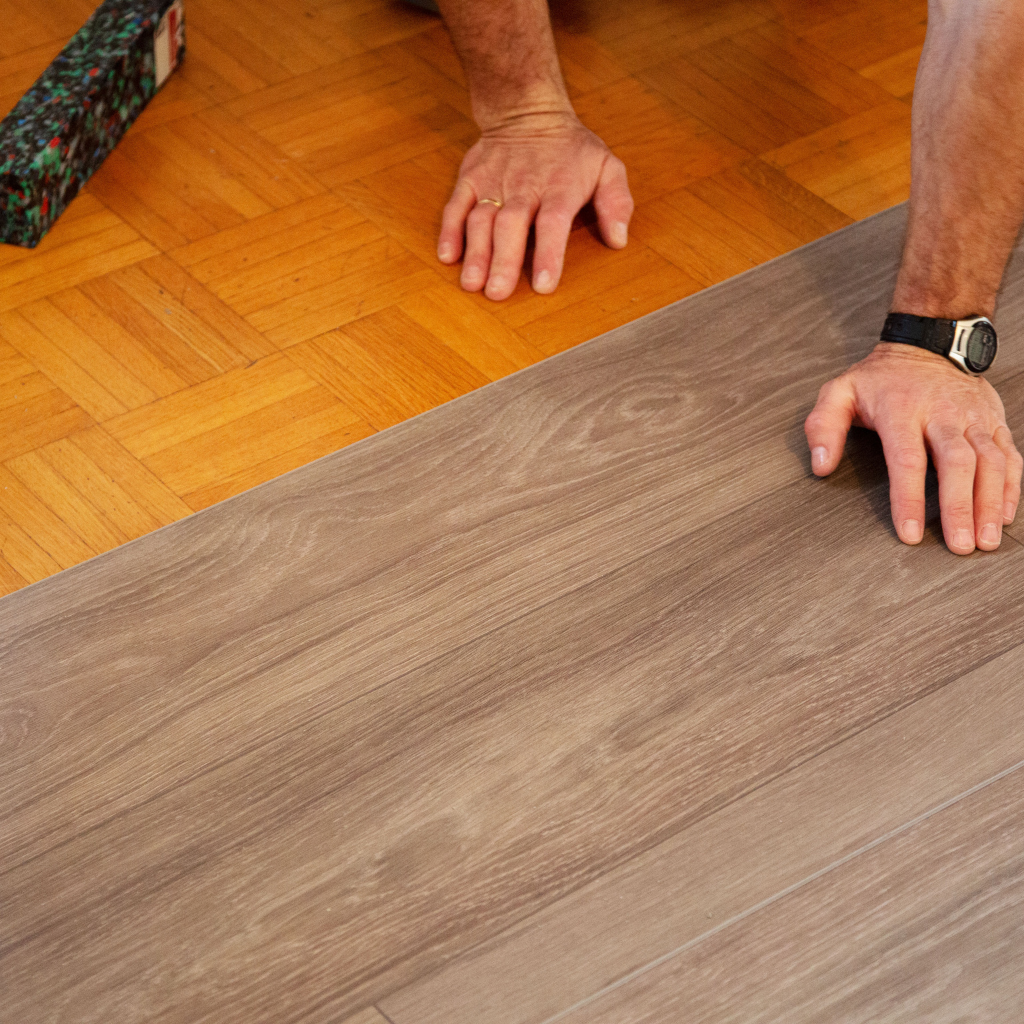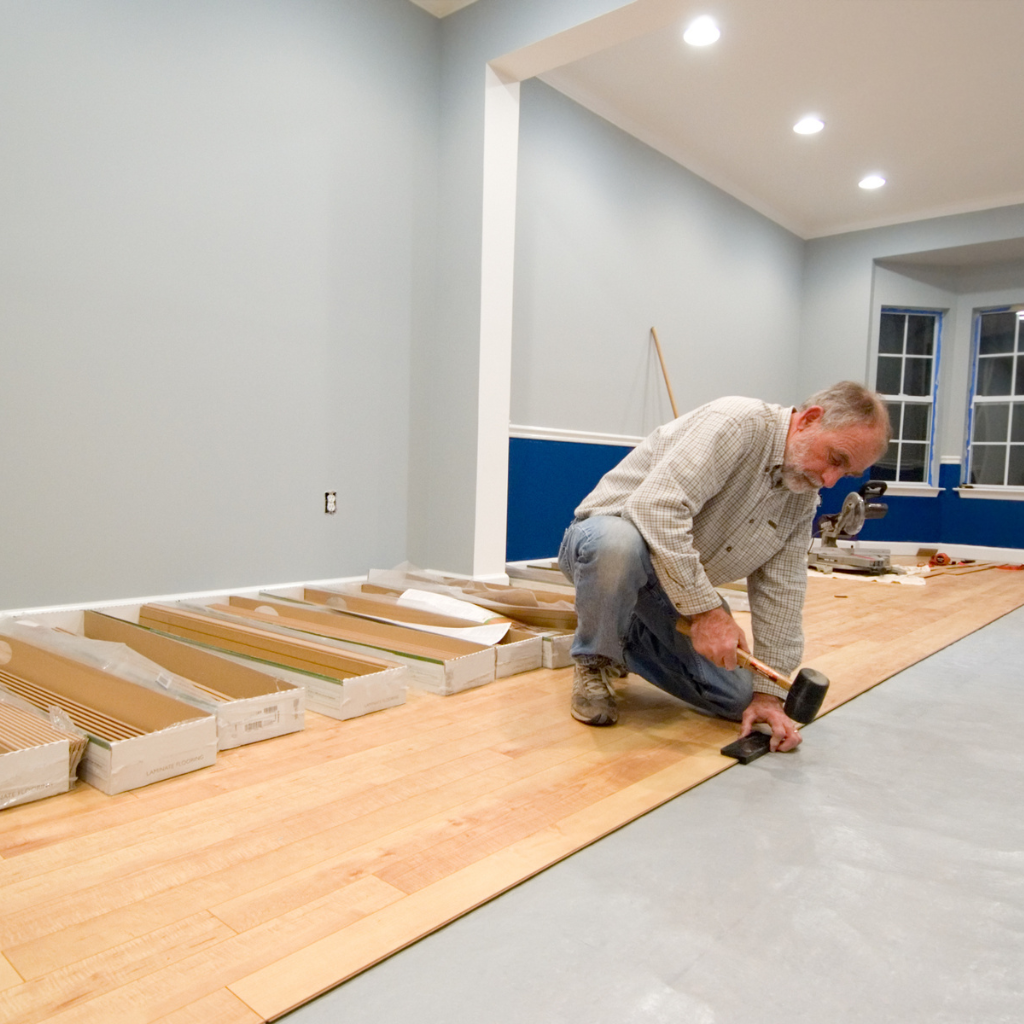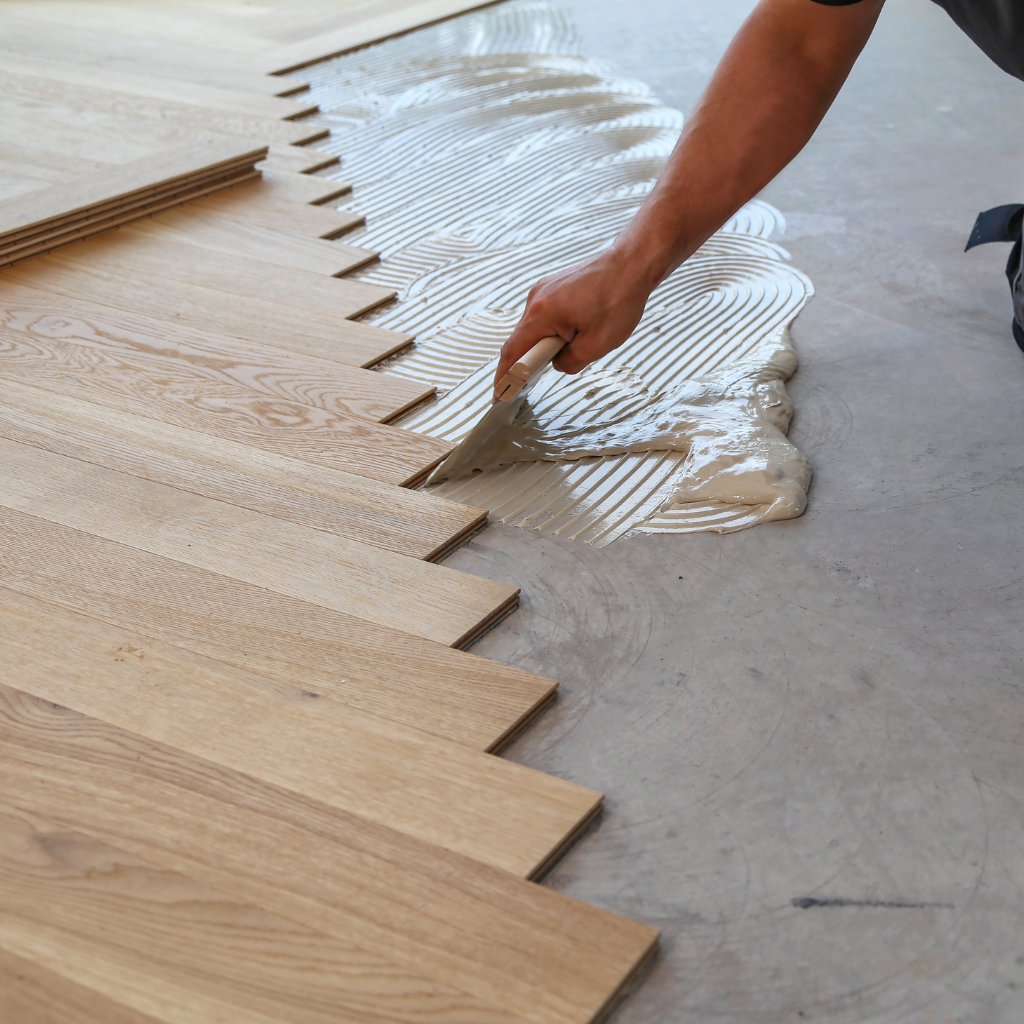Choosing the right floor for your home can be tough. With so many options, it takes time to figure out it's where to start. That's where "What is vinyl flooring" comes in. This material offers a blend of style, durability, and affordability that few other floors can match.
We'll cover everything from its types to how you can maintain it for years.
Our family-run business brings decades of experience in providing top-notch flooring solutions directly to your door. We pride ourselves on offering high-quality vinyl and laminate flooring without the high street price tag.
Ready to find out what makes vinyl an excellent choice for any room in your home? Keep reading!
Vinyl flooring refers to a durable, versatile floor covering made from polyvinyl chloride (PVC), along with other compounds. This flooring is available in sheets, tiles, or planks and can imitate the look of natural wood or stone thanks to its realistic textures and patterns.
Homeowners often choose vinyl flooring for their kitchens and bathrooms because it's waterproof and easy to clean. The market offers various styles of vinyl, including luxury vinyl tile (LVT) and rigid core products that cater to different tastes and budgets.
Luxury Vinyl Tile (LVT) offers an excellent balance between affordability and performance for those looking to mimic real hardwood or stone floors.
With the wide range of types available – from flexible sheet vinyl flooring to luxury vinyl planks that click together without adhesive – there's a suitable option for virtually any room in your home.
Its ease of installation means DIY enthusiasts can lay down new flooring with minimal tools required, making it a popular choice among homeowners, interior designers, decorators, builders, and contractors alike.
Comparing vinyl flooring to laminate flooring illuminates the distinctive features and advantages of each, catering to diverse preferences and uses in homes and commercial spaces. Below is a detailed comparison structured for clarity.
| Feature | Vinyl Flooring | Laminate Flooring |
|---|---|---|
| Material Composition | Made from synthetic materials with a PVC base | Constructed from composite wood pressed together at high temperatures |
| Water Resistance | Highly water-resistant, making it suitable for bathrooms and kitchens | Less water-resistant due to wood composition, not recommended for high moisture areas |
| Installation | Can be installed over existing flooring, requires less subfloor preparation | May need more subfloor preparation, not suitable over existing flooring |
| Durability | Resilient and durable, withstands heavy foot traffic | Durable, though susceptible to scratching and moisture damage over time. |
| Cost | Generally more affordable, varying by quality and style | Can be costlier, especially higher-end options |
| Maintenance | Simple to maintain and clean, with routine sweeping and occasional care mopping | Requires regular cleaning, sensitive to standing water and spills |
| Environmental Impact | Less eco-friendly, difficult to recycle due to PVC composition | More eco-friendly, made from recycled wood but contains resins and glues |
| Appearance and Feel | Offers a wide range of designs, closely mimics natural materials | Has a realistic wood look but may feel harder underfoot |
This comparison elucidates that both vinyl and laminate flooring offer unique benefits. Your decision depends on your particular requirements, such as moisture resistance, cost, and the desired look for your space. Moving on, explore the different types of vinyl flooring available.
Vinyl flooring offers homeowners and professionals a versatile and affordable solution. Its wide range of styles fits any room, from kitchens to living rooms.
As we explore how these advantages affect choosing the right type of vinyl for your project next, consider how factors like room usage may influence your decision.
Homeowners often choose vinyl flooring for its range of options and durability. The main types available are luxury vinyl tile (LVT), vinyl sheet, and vinyl plank flooring.
Each offers a unique look and feel to suit any room. LVT stands out for mimicking the resembles natural materials like wood or stone, but at a much lower cost. It's particularly popular in kitchens and bathrooms because it can withstand high-traffic areas, damage, and moisture.
Rigid core vinyl represents a significant advancement from traditional options. This type features a sturdy core layer that provides extra stability and resistance against dents and wear.
Its rigid structure makes it a perfect option for spaces with high foot traffic. Or heavy furniture placement. Unlike other types, rigid core vinyl can combat fluctuations in temperature without warping, making it perfect for any room in your home.
Choose a vinyl floor based on where you'll install it – each type has its benefits.

Vinyl flooring provides a flexible and long-lasting solution for homes, blending well with various interior designs. Its popularity comes from its capacity to replicate natural materials like wood and stone without the hefty price tag or maintenance fuss.
Each main type of vinyl flooring available offers its own set of advantages, catering to different needs, tastes, and budget requirements. With options ranging from traditional sheet vinyl to innovative rigid core vinyl solutions, there's a practical choice for every space within your home or project scope.
Transitioning into considerations about durability highlights another important aspect homeowners should evaluate when choosing the right kind of vinyl flooring for their spaces.
Moving from the broader category of vinyl flooring, we now focus on luxury vinyl tile (LVT). LVT stands out as a high-end version of vinyl flooring. It mimics the look and Feel of natural materials like wood or stone but at a more affordable price.
Homeowners appreciate LVT for its realistic textures and range of colors. Interior designers often recommend it for both bathroom and kitchen projects due to its moisture resistance.
Builders find luxury vinyl tile easy to install without the need for glue or nails, thanks to modern click technology. This feature ensures a quick setup, making it popular in commercial spaces where time is money.
Contractors also value LVT because it comes with an integrated underlay, enhancing comfort underfoot while providing sound insulation. The material's ability to withstand direct sunlight without fading adds to its appeal for sunny rooms or areas exposed to UV light.
Rigid core vinyl sets itself apart from other flooring options due to its solid core that offers enhanced durability and stability. This flooring is built to endure high foot traffic, making it a great choice for both homes and commercial spaces.
Unlike traditional vinyl that may flex or indent under pressure, rigid core vinyl maintains its shape and appearance under the toughest conditions. Its construction includes a dense composite core that resists impacts, scratches, and stains much more effectively than softer alternatives.
Rigid-core vinyl flooring combines the beauty of natural materials with unprecedented strength, making it perfect for busy families and commercial environments.
Furthermore, this flooring solution features a locking system for easy installation without the need for adhesives. Homeowners find this feature particularly appealing as it simplifies laying vinyl flooring while ensuring a snug fit across all edges.
Rigid core's waterproof properties also make Perfect for kitchens, bathrooms, and other moisture-sensitive areas where traditional hardwood or laminate might not be appropriate.
The mix of practicality and aesthetic value makes rigid core vinyl a versatile option among different types of vinyl flooring available today.
Vinyl flooring stands out as a highly durable material, perfect for high-traffic areas like dining rooms and hallways. The wear layer on top of the vinyl planks or tiles protects against scratches, dents, and stains, making it perfect for busy households.
The thickness of this layer differs depending on the quality of the flooring; thicker layers offer more protection and, thus, a longer life span.
Factors such as quality of installation and type of vinyl play a crucial role in its durability. Vinyl flooring can be installed easily by following proper steps which contributes to its longevity.
On the downside, sharp objects and extreme temperatures may cause damage if caution is not exercised. Despite these potential disadvantages of vinyl flooring, its resilience against everyday wear makes it a popular flooring choice among homeowners, interior designers, decorators, builders, and contractors looking for both style and durability.

Durability is key in choosing vinyl flooring. Several factors can affect how long your new vinyl floor will last.
Each factor plays a part in determining how well your luxury vinyl flooring solutions stand up to daily use, ensuring you enjoy beautiful floors for years to come.
Vinyl flooring offers a versatile and stylish option that caters to many homes and businesses. However, it's important to consider some potential drawbacks before deciding to install vinyl flooring.
Each of these points plays a crucial role in determining whether vinyl flooring is the right choice for specific needs and environments. Choosing the best type of flooring requires careful consideration of these disadvantages alongside the benefits of vinyl flooring.
Installing vinyl flooring can revitalize any room, giving it a contemporary touch and simplified cleaning. This vinyl installation guide ensures you achieve a seamless and hard-wearing finish.
Following these directives, both homeowners and professionals can install vinyl flooring effectively, augmenting any interior design endeavor with long-lasting, appealing floors.
Installing vinyl flooring can transform your living space, adding beauty and durability. Here are the key steps you need to follow for a successful installation:
By following these steps, you can ensure that your vinyl flooring is installed correctly for years of enjoyment.
Laying vinyl flooring requires a specific set of tools to achieve an excellent fit and finish. Homeowners, interior designers, decorators, builders, and contractors all play a crucial role in this process, ensuring the use of correct equipment for seamless installation.
Each tool plays its part in simplifying the installation process, making it easier for those looking to install their own flooring or professionals aiming for perfection in their projects.
Moving on, let's discuss how to maintain your newly laid vinyl flooring for longevity and sustained beauty over time.

Maintaining vinyl flooring properly can significantly extend its life and keep it looking new. Regular cleaning is essential for this upkeep. Homeowners should dust or vacuum the floor weekly with a soft brush attachment to prevent damaging the surface.
Spills need immediate attention with a damp mop or cloth, making sure that water does not seep through the edges. For tougher stains, using a dedicated vinyl floor cleaner yields the best results without damaging the material.
Dealing with scratches on your vinyl flooring requires gentle methods to prevent further damage. Minor scratches can usually be removed by buffing with a soft, dry cloth. For deeper scratches, special vinyl repair kits are available that fill and seal the damage, blending it seamlessly with the surrounding area.
Avoid dragging furniture across your floor, and use protective pads under heavy items to preserve your vinyl's finish and maintain its appearance over time.
Maintaining vinyl flooring ensures it remains beautiful and durable for years. With proper maintenance, your floors will stay looking as good as new.
Following our conversation on vinyl flooring upkeep, we must concentrate on the optimal cleaning methodologies for this kind of flooring. Upholding the state of your vinyl floor calls for particular strategies.
These procedures guarantee that homeowners and professionals can keep their vinyl flooring in pristine condition for an extended period without resorting to intricate tools or severe chemicals—just simple maintenance and care routines adjusted for the necessities of this long-lasting material.
Dealing with scratches on vinyl flooring requires a straightforward approach. If you spot a scratch, clean the area gently to remove any dirt. Then, use a repair kit designed for vinyl floors.
These kits can fill in scratches, making them almost invisible. For deeper scratches, applying wax or sealant offers an effective solution. Always follow the product instructions carefully.
Maintaining vinyl flooring to prevent scratches involves regular cleaning and using protective pads under furniture. Avoid dragging heavy objects across the floor. Place doormats at entrances to catch grit that could scratch the floor when walked inside.
With these simple steps, your vinyl flooring can remain looking new for years, highlighting why it's a favored choice among homeowners and decorators seeking long-lasting solutions.
Choosing the right flooring is vital for any space, be it a home or commercial area. Vinyl flooring stands out with its variety and durability. It meets diverse needs and tastes, ranging from luxury vinyl tile (LVT) to rigid core designs.
Each type brings unique advantages to the table, making vinyl suitable for different settings and uses.
For those planning to refresh their spaces, understanding the main types of vinyl flooring available can guide your decision. Knowing about vinyl flooring helps in selecting a floor that combines aesthetics with functionality efficiently.
Installation and maintenance are straightforward, ensuring longevity and ease of care over time. With this knowledge, homeowners and professionals can make informed choices about their flooring projects.